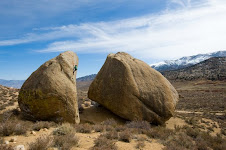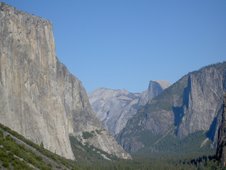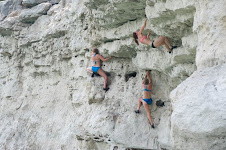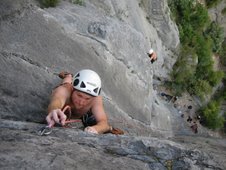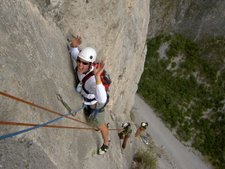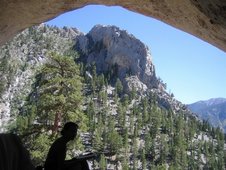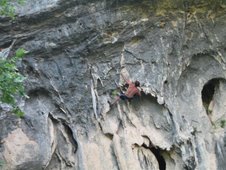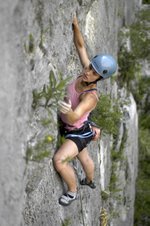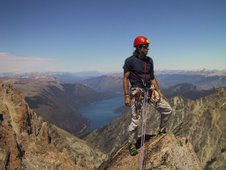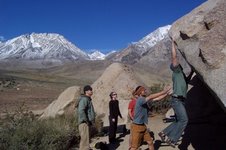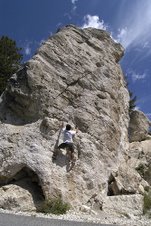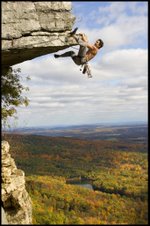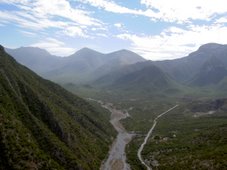I notice a drastic change in my mood and overall happiness when I don’t get my regular “fix” of climbing. This past month I have only climbed outdoors twice and it seems to be taking a bit of a toll on me. A month ago I had just sent my project and I felt great, a feeling that would be hard to top. Then, next thing you know…a missed day here…a missed day there…it’s been a month and I haven’t hardly climbed at all.
Friday, April 27, 2007
I need my fix
I notice a drastic change in my mood and overall happiness when I don’t get my regular “fix” of climbing. This past month I have only climbed outdoors twice and it seems to be taking a bit of a toll on me. A month ago I had just sent my project and I felt great, a feeling that would be hard to top. Then, next thing you know…a missed day here…a missed day there…it’s been a month and I haven’t hardly climbed at all.
Thursday, April 19, 2007
Climber Profile: Randy Ho a.k.a. Crag Napper

Height: 5' 8"
Ape Index: -3"
Favorite Climb / Crag: "Hoo Doo you love?" –
Current Project: That climb that keeps giving me whippers
Portfolio: Alpine, Sport, Trad, Bouldering
Motto: If you can't reach it, dyno
A profound quote from Randy: “You can't drink beer _and_ climb at the same time...or can you…hmmm…this give me an idea.”
More than just a narcoleptic, Randy Ho is quite an active person. He’s the only climber I know that will run a full marathon on Saturday and be out at the crag either later that day or the next.
He’s a time optimist, which sometimes leaves him napping at the crag to recover from the previous night’s “clubbing marathon.” When I lived in
climbers that would be out with me till the late hours in the night promising to rendezvous in the morning for some hard cranking…and actually show.
But, credit is due. One prod and he stirs out of sleep to step into his harness and jump right onto his latest project. And, as these photos prove, he may need that rest to push through the extreme emotional states he experiences in sending a route. He’ll go from happy, to serious, to ANGRY in seconds.
One reason why you don’t disturb him from his sleep.
Saturday, April 14, 2007
2007 Limestoner Comp - Austin, TX
 March 24th marked the latest annual limestone climbing competition in Austin. This year, like last year it was held entirely at Reimer's Ranch. The new county park that the local climbing club (Central Texas Mountaineers) worked hard to get on the public ballot and even harder to get the voter turnout to buy the 1,000 acres on the Pedernales river just west of Austin.
March 24th marked the latest annual limestone climbing competition in Austin. This year, like last year it was held entirely at Reimer's Ranch. The new county park that the local climbing club (Central Texas Mountaineers) worked hard to get on the public ballot and even harder to get the voter turnout to buy the 1,000 acres on the Pedernales river just west of Austin.This was the biggest turnout yet and we expect it to keep growing. Over 100 people attended with 86 registered competitors (63 in 2006, 42 in 2005). Threat of rain may have kept people away, so next year I would expect over 100 competitors.
 Besides the sport climbing, this was the first year we held a separate bouldering comp. We had recently put up 90+ new problems in the park.
Besides the sport climbing, this was the first year we held a separate bouldering comp. We had recently put up 90+ new problems in the park.We raised $2,115 that is used for our trail work and route maintenance throughout Austin.
After the comp we held the dinner, event awards, silent auction, door prizes and a slide show by Merrick Ales .
 On Sunday after the comp we held seminars. Jason Kehl provided instruction on bouldering techniques ( Yes, that Jason Kehl). Rock About guide service put on self rescue clinics. Other clinics were held as well.
On Sunday after the comp we held seminars. Jason Kehl provided instruction on bouldering techniques ( Yes, that Jason Kehl). Rock About guide service put on self rescue clinics. Other clinics were held as well.Monday, April 9, 2007
Climbing Accidents: We need to brush up on climbing safety
A New Generation
The recent propagation of climbing's popularity has created an influx of new climbers, new vendors and new technology to our crags. Gym climbers blinded by the safety and expediency of gym climbing are seeking to try their hand at outdoor rock; increased traffic at local crags is spawning the birth of easy clip anchors for effortless cleaning and quick turn around of routes; and the birth of a generation of convenience is pushing people to climb with less training, less understanding and a lack of proper climbing safety knowledge. While many of these things are nice and make life and climbing more convenient, they can also create safety concerns. I am sure there are other climbing safety sources, but I highly recommend reading Mountaineering: Freedom of the Hills and Self-Rescue to brush up on playing it safe at the crag.
Hardware
Hardware requires the eyes of all climbers in the community to inspect and inform local climbing regulatory agencies to rebolt when necessary. The weather, traffic, rock fall or erosion, and improper use can, and will, wear down hardware. If a bolt is spinning, has lots of rust or just looks plain haggard, it likely needs to be rebolted. Also, be weary of webbing or draws that have been left behind. Visit The American Safe Climbing Association (ASCA) for more information. http://www.safeclimbing.org/
Rock Fall
Rock fall, although sometimes a natural occurrence, can be either avoided or the risk mitigated. Its common sense to wear a helmet in areas with tons of rock fall (El Potrero Chico). Avoid pulling on loose or hollow sounding rock. If it flexes when you pull on it or sounds like a bongo when you knock on it, don't use it. Also, if you can redirect your rope to not let it dislodge loose rock onto your belayer or climbers below, it's always ideal. Most importantly, yell "ROCK!!!" if you knock something off.
Human Error / Negligence
Many of these accidents occur when climbers don't tie-in appropriately, don't tie a knot in the end of their rope when belaying or rappelling, fail to set up an appropriate anchor, or aren't paying attention when belaying. As climbers and as human beings, if accidents don't happen regularly, it's easy to become lax on safety, especially when double checking knots and equipment, and belaying. When the crags get crowded we have to stay focused.
Be Prepared
Beyond the recommended reading, I would also highlight the importance of having some sort of wilderness medical training and even potentially rescue insurance. Having the know-how to resuscitate and check for spinal injuries could mean the difference in your climbing buddy making it at all, much less climbing again. Additionally, the American Alpine Club offers rescue insurance, which could come in handy when climbing in back country or international destinations where assistance may financially ruin you. Insurance at all is key. Think about it, if you’re already surviving on a shoe string camping out at crags, what’s going to happen when you owe $30K in hospital bills because you wanted to save $60 a month in insurance?
Support
As climbers we rely on each other for support in pulling the crux and topping out our projects. The same goes for recovering from a serious injury. If you know someone who has been injured reach out to them with moral or financial help if needed. Same goes for others involved in incidents, whether it’s the belayer or someone at the scene, it’s always best to do what we can to keep them stoked and not traumatized.
It seemed important to highlight some of the things that came to mind when I heard about several of the recent climbing incidents. And, since climbing incidents happen and are sometimes unavoidable, it's always best to be prepared. Most importantly, have fun when you're climbing. That's really what it's all about. After all avoiding accidents will allow you to avoid missing more climbing.
Know of some good climbing safety resources? Have a case study or injured friend in need? Leave a comment and let us know what's going on.
Resources:
*The American Alpine Club, particularly their Accidents in North American Mountaineering book http://www.americanalpineclub.org/index.php
*The American Safe Climbing Association (ASCA) http://www.safeclimbing.org/
*Book – Mountaineering: The Freedom of the Hills http://www.amazon.com/Mountaineering-Freedom-Hills-Mountaineers-Society/dp/0898868289
*Book – Self-Rescue http://www.amazon.com/Self-Rescue-Rock-Climb-David-Fasulo/dp/0934641978/ref=pd_bbs_sr_2/10394605455014209?ie=UTF8&s=books&qid=1176141930&sr=1-2
*Tradgirl Climbing Safety FAQ Page http://www.tradgirl.com/climbing_faq/safety.shtml
*
*The forum pages of Rockclimbing.com can host some good recommendations and case studies http://www.rockclimbing.com/
*Wilderness First Responder on Wikipedia http://en.wikipedia.org/wiki/Wilderness_First_Responder
Monday, April 2, 2007
The Crux
 Working through the crux of a route can be one of the most rewarding and exhilarating things about climbing. That anxiety that you have to fight back. The patience you have to develop in order to think it through accurately. The guts you have to evoke to pull through that “heady” section. But, a crux can also be a show stopper. If your heads not in it, your motivation drops and your energy all together fades.
Working through the crux of a route can be one of the most rewarding and exhilarating things about climbing. That anxiety that you have to fight back. The patience you have to develop in order to think it through accurately. The guts you have to evoke to pull through that “heady” section. But, a crux can also be a show stopper. If your heads not in it, your motivation drops and your energy all together fades.
You have to stay psyched and know when to give it a rest and come back to it another day. I get excited about projects. It’s nice to have climbs to think about while you’re laying in bed or at work. It gives you something to look forward to. A genuine challenge you can set your sites on.
I often compare climbing as an analogy to life obstacles as well. In work we get bummed out if we aren’t being challenged. We prefer being engaged and to set goals and work towards achieving them. The same goes for relationships, but I am not so sure I want to go there right now.
I feel lucky to have a passion that pushes me to try harder, forget about pain and climb on. I think it’s important to have something to look forward to, especially if you’re stuck working behind a desk many of your days.



